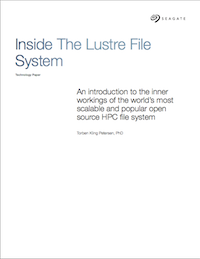In this special guest feature, Robert Roe from Scientific Computing World speaks with Lee Margetts, chair of PRACE’s industrial advisory committee, about its work to increase the engagement of industrial HPC users.
With the rise in complexity of engineering products and increased competitiveness in many industries, HPC can be used to accelerate the time to market for new products, or enable new concepts to be tested and executed much faster than with traditional processes. However, setting up an HPC facility comes at a huge cost, both in terms of facility and the staff costs needed to support the system and develop HPC expertise.
The Partnership for Advanced Computing in Europe (PRACE), an international non-profit association of European countries, is trying to accelerate the process of industrial uptake of HPC resources to bolster European competitiveness, skills development and technology transfer. This is being accomplished through changes to its policy around how projects are awarded time on the largest HPC systems in Europe.
PRACE provides open calls with pre-defined allocations of core hours on European supercomputers provided by partners, but the way this time is allocated is now changing, to encourage better engagement with industrial users.
Not all projects are created equal
Industry proposals will now be appraised against other industry projects, rather than scientific proposals. 10 per cent of the allocation of core hours will now be devoted solely to industrial users. All of these changes will help encourage the use of large-scale HPC systems by European industry.
This change was brought about by PRACE’s development of its Industrial Track Pilot, and hopes to inspire more companies in Europe to take up the use of HPC. “Tier-0 is the key to this particular project,” said Dr Lee Margetts, chair of the Industrial Advisory Committee (IAC) for PRACE. “When we started in 2013, PRACE set up an IAC to give advice about improving engagement with industry, and the impression that I get is that this was motivated by the European Commission wanting to see their investment have a benefit to job creation and technology transfer.”
So in their open calls for the Tier-0 access they had some companies apply, but not very many, and that is to be expected because there are few companies able to make use of that type of facility. However, the number of companies applying to their open calls has been dropping,” said Margetts.
This helped to initiate the process of reviewing the way that PRACE dealt with industrial users, but this is further complicated by the complex nature of the PRACE organization and its partners. While it is funded by the European Commission, PRACE relies on European states to provide access to some of the largest supercomputers in the EU and figuring out who gets to use these resources is no easy task.
Over a long period of time there have been discussions about how to improve access, and this pilot that was launched in March, has taken about a year to set up,” said Margetts. “The aim is to improve the number of companies applying to PRACE open calls. The way that it works is that people who apply from industry or firms that apply, their proposals are ranked and compared with each other in their own independent bubble, rather than, which has previously happened, being compared to scientific proposals. I think what has happened over the years is that applicants from industry have been compared against the same criteria as science applicants, and they always rank at the bottom because a company cannot compete.”
“An example would be the recent high-profile scientific output which was the image of the black hole [published in April]. This is a good example because if you are ranking proposals on scientific excellence, a company that wants to improve a widget, cannot compete on that criteria,” added Margetts.
Naturally, when PRACE said they want to engage with industry and increase the number of proposals in 2013, there was an increase but as companies face rejection after rejection, they become less motivated to apply again,” said Margetts. “The idea is to give industry a chance by having their proposals ranked against each other, rather than a visualization of a black hole.”
“This new approach coupled with the allocation of core hours, specifically for industrial users, will give new opportunities to them. This will help to give confidence to applying firms, as their projects will be appraised more favourably in the current open call, and future calls for projects.”
Providing a path to Tier-0
Another challenge facing the PRACE organization is helping to facilitate industrial users in their journey to using Tier-0 HPC resources. While some may argue that most industrial users – outside of aerospace and large automotive companies – do not need Tier-0 computing resources, this argument could have been used in the same way when looking at academic users.
Tier-0 resources are the largest and most powerful HPC systems. Due to the sheer scale and complexity of scaling code to thousands of nodes, there is some difficulty, particularly for new users. If you have never used a Tier-1 or Tier-2 system, then it stands to reason that you would not have the kind of skills and experience to deliver code that can scale effectively on a Tier-0 machine.
To combat this for scientific research, PRACE has developed an infrastructure to help users develop their skills as they progress through the tiers. An academic user, for example, may start at a local cluster where they develop their code on a local academic cluster at their university before moving up to national resources. Once the researchers have gained the relevant skills and shown that their code can scale sufficiently, they can apply to use Tier-0 resources from PRACE.
To support these users there is a clear pathway alongside PRACE training centers to get users from Tier-2 to Tier-1. Once that has been accomplished, there is more support in the form of High Level Support Teams – such as the one at the Barcelona Supercomputing Center (BSC), which can help scientists further refine their code in preparation for the use of Tier-0.
The argument from the IAC is that every part of the scientific ecosystem either needs to be available for industry users, or there needs to be a parallel set of services that help industry,” said Margetts.
If you build it, they will come
Support for industrial users is increasing fast. The SME HPC Adoption Programme in Europe (SHAPE) initiative is an example of work being done by PRACE to help facilitate the transition into using larger HPC systems. While it aims specifically at SMEs, it does provide an opportunity for companies to develop skills with HPC.
Tier-2 is where you have the SHAPE programme, which introduces a company to the benefits of HPC. Once a company has graduated from the SHAPE programme, they might be able to use their local national Tier-1 systems and then move up to Tier-0, so it is positive in the way that it opens up the ecosystem and gets industry to think about the way they can access HPC resources,” said Margetts.
This brings the other parts of the ecosystem into the limelight, because in order to use the PRACE Tier-0, you need to show that your code scales on a system. There is another access mechanism to do that, which is preparatory access,” he added.
The objective of preparatory access is to allow PRACE users to optimize, scale and test codes on PRACE Tier-0 systems before applying to PRACE calls. Production runs are not allowed as part of PRACE Preparatory Access but can help to develop the necessary skills and give confidence that a particular code will run at the scale needed to make the most of a Tier-0 system.
The SHAPE programme has already helped around 60 companies but the legacy of this and the other programmes are not only the work that has been done through these projects. PRACE is helping change the mindset around the industrial use of HPC.
Opening up the use of large-scale HPC resources to industry users is not an easy task but, by doing so, PRACE is proving that there are companies out there that not only have challenges that require HPC, but those industry users are more than capable of making use of the top echelon of HPC systems in Europe.
While it may take some time before the use of HPC is as widespread in industry as it is in the scientific community, this work must be done in order to let European industry compete on a truly global level. The skills that are developed and the technology transfer will help to drive these companies forward for years to come.
There are a lot of problems in society at the moment. We have a lack of antibiotics, a need for clean energy, issues with climate change and a big issue with plastic waste. For me, these investments in infrastructure benefit the European citizen and the pathway for that is having a good relationship between scientists and people in companies,” concluded Margetts.
This story appears here as part of a cross-publishing agreement with Scientific Computing World.





